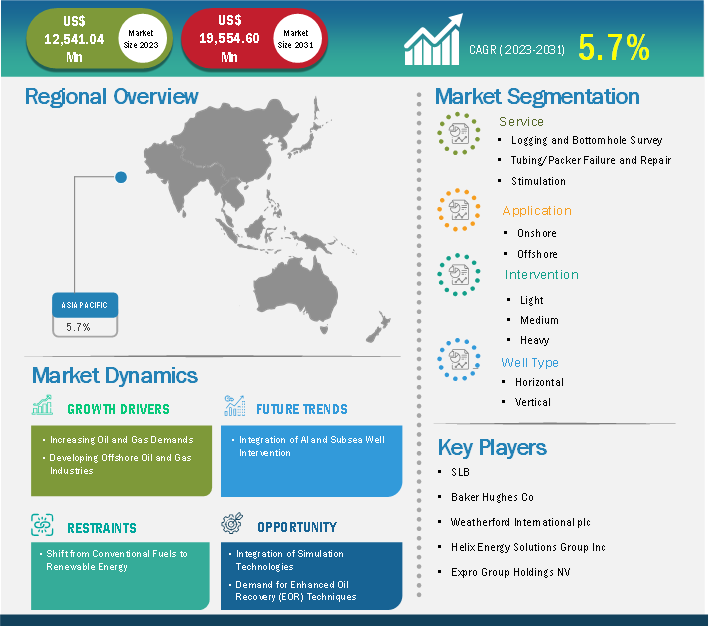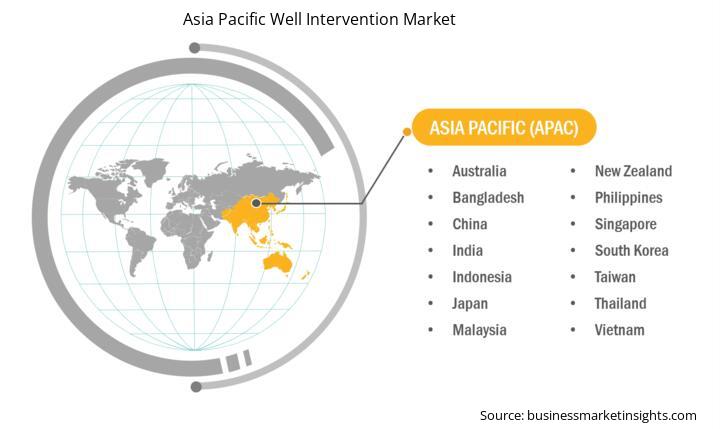Asia Pacific Well Intervention Market Report (2021-2031) by Scope, Segmentation, Dynamics, and Competitive Analysis
No. of Pages: 150 | Report Code: BMIRE00031804 | Category: Energy and Power
No. of Pages: 150 | Report Code: BMIRE00031804 | Category: Energy and Power
The Asia Pacific Well Intervention Market size is expected to reach US$ 19,554.60 million by 2031 from US$ 12,541.04 million in 2023. The market is estimated to record a CAGR of 5.7% from 2023 to 2031.
The well intervention market in Asia Pacific is segmented into China, India, Australia, South Korea, Indonesia, Malaysia, and the Rest of Asia Pacific. The region is a significant consumer of oil and gas, with China and India being the largest consumers. Rapid industrialization, urbanization, and population growth have driven the demand for energy in the region. Nonetheless, Asia Pacific is also home to substantial oil and gas reserves. Countries such as China, India, Malaysia, Indonesia, and Australia have significant domestic production capacities. In addition, the discovery and construction of new offshore oil and gas fields across different countries are the key factors driving the demand for well intervention services across Asia Pacific. In July 2023, Petronas, the Malaysian government company, announced 6 new locations for offshore oil and gas facilities. In July 2022, the Philippines announced its plan to redevelop its 30-year-old Cadlao Oil Field, which would provide a boost to its offshore oil production capacity in the coming years. Similarly, in May 2022, The Hoang Long joint operating company in Vietnam secured a jack-up drilling rig for their planned offshore development wells in the Cuu Long basin. Such developments are expected to drive the growth of the well intervention market in Asia Pacific in the coming years.

Key segments that contributed to the derivation of the well intervention market analysis are service, application, intervention, and well type.
Well intervention using simulation technologies involves the use of specialized software programs or physical models that are carefully created to replicate a variety of operations inside the well. These operations span the drilling, completion, and production phases of a well's life cycle. The primary purpose of these simulators is to provide a realistic, reliable, and safe environment for training, strategic planning, and improving intervention activities. Simulation software and programs can replicate various well intervention methods, including wireline services, coiled tubing services, hydraulic workover, snubbing, and fishing services. Their capabilities are extended to mimic the behavior of an oil and gas well and its adjacent formation under various operational scenarios. These scenarios include fluctuations in well pressure and temperature, changes in well geometry, and changes in reservoir properties. In addition, the simulators can accurately reproduce the responses of various intervention tools and devices such as pumps, valves, and sensors. This allows operators to practice precise operation and placement of well intervention tools in a controlled and safe environment.
The integration of well intervention simulators brings a variety of benefits to the oil and gas industry. These simulators play an essential role in reducing the risk of accidents by allowing oil and gas operators to hone their skills in a risk-free environment. They also contribute to greater operational efficiency by providing operators with a platform to refine their techniques and strategies. Moreover, digital twin technology, creating virtual representations of physical assets and processes, is becoming increasingly crucial in subsea well interventions. Digital twins provide real-time insights into well performance and further enable engineers to simulate and optimize intervention operations. By using digital twins, engineers can test different intervention scenarios, identify potential risks, and optimize workflow. These virtual tests minimize the need for physical testing and save time and resources while increasing the safety and efficiency of subsea well operations. Additionally, these software simulators facilitate the improvement of the overall quality of well intervention jobs throughout the well lifecycle. They allow operators to identify potential problems and evaluate various intervention strategies before implementing them in real-field scenarios. They not only contribute to time and cost savings but also increase the safety and efficiency of assets. Moreover, the oil and gas industries can proactively address challenges associated with well intervention operations and ensure optimal performance through refined processes, ultimately improving the sustainability and success of oil and gas operations. Thus, the integration of simulation technologies is expected to bring significant growth opportunities in the well intervention market in the coming years.
Based on country, the Asia Pacific well intervention market comprises Australia, China, India, South Korea, Indonesia, Malaysia, and the Rest of Asia Pacific. India held the largest share in 2023.
India operated 60 onshore and 16 offshore oil and gas rigs in 2023, compared to 64 and 13, respectively, in 2022. Crude oil production in India accounted for 4.9 million metric tons during April to May 2024. The oil and gas sector is one of India's eight core industries and plays an important role in decision-making for all other major economic sectors. India's economic growth is linked to its energy needs. Therefore, the demand for oil and gas is expected to increase, making the sector quite favorable for investment. India retained its place as the world's third-largest oil consumer in 2023. As a relatively small oil producer with limited potential for near-term growth, India's domestic production covered only 13% of India's supply needs. In 2023, domestic crude oil production averaged around 700 thousand barrels per day. As per the India Brand Equity Foundation, the oil and gas industry is expected to attract US$ 25 billion in investment in exploration and production of oil and gas. The rise in initiatives toward increasing oil and gas production is anticipated to fuel the demand for well intervention in the coming years.
| Report Attribute | Details |
|---|---|
| Market size in 2023 | US$ 12,541.04 Million |
| Market Size by 2031 | US$ 19,554.60 Million |
| CAGR (2023 - 2031) | 5.7% |
| Historical Data | 2021-2022 |
| Forecast period | 2024-2031 |
| Segments Covered |
By Service
|
| Regions and Countries Covered | Asia Pacific
|
| Market leaders and key company profiles |
|
Some of the key players operating in the market include Halliburton Co, Baker Hughes Co, Weatherford International Plc, Expro Group Holdings NV, Oceaneering International Inc, Archer Ltd, Schlumberger NV, Forum Energy Technologies Inc, Helix Energy Solutions Group Inc, and Trican Well Service Ltd., among others. These players are adopting various strategies such as expansion, product innovation, and mergers and acquisitions to provide innovative products to their consumers and increase their market share.
The following methodology has been followed for the collection and analysis of data presented in this report:
The research process begins with comprehensive secondary research, utilizing both internal and external sources to gather qualitative and quantitative data for each market. Commonly referenced secondary research sources include, but are not limited to:
Note: All financial data included in the Company Profiles section has been standardized to USD. For companies reporting in other currencies, figures have been converted to USD using the relevant exchange rates for the corresponding year.
The Insight Partners’ conducts a significant number of primary interviews each year with industry stakeholders and experts to validate its data analysis, and gain valuable insights. These research interviews are designed to:
Primary research is conducted via email interactions and telephone interviews, encompassing various markets, categories, segments, and sub-segments across different regions. Participants typically include:

The Asia Pacific Well Intervention Market is valued at US$ 12,541.04 Million in 2023, it is projected to reach US$ 19,554.60 Million by 2031.
As per our report Asia Pacific Well Intervention Market, the market size is valued at US$ 12,541.04 Million in 2023, projecting it to reach US$ 19,554.60 Million by 2031. This translates to a CAGR of approximately 5.7% during the forecast period.
The Asia Pacific Well Intervention Market report typically cover these key segments-
The historic period, base year, and forecast period can vary slightly depending on the specific market research report. However, for the Asia Pacific Well Intervention Market report:
The Asia Pacific Well Intervention Market is populated by several key players, each contributing to its growth and innovation. Some of the major players include:
The Asia Pacific Well Intervention Market report is valuable for diverse stakeholders, including:
Essentially, anyone involved in or considering involvement in the Asia Pacific Well Intervention Market value chain can benefit from the information contained in a comprehensive market report.